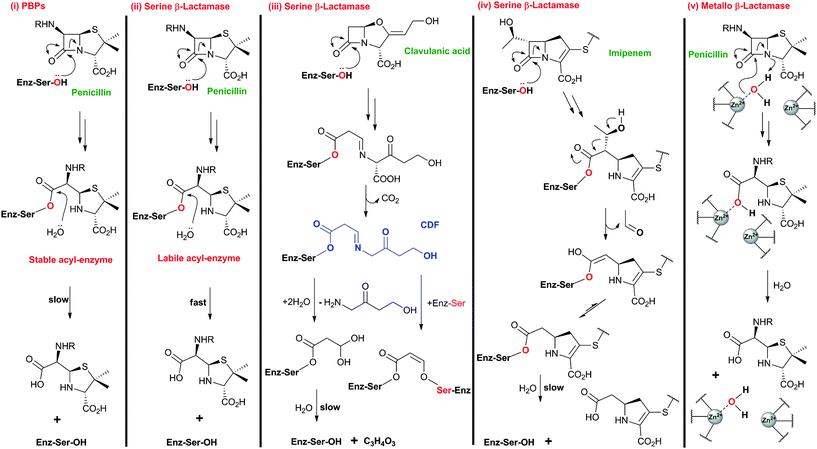



In addition, ceftolozane/tazobactam may represent alternative therapy to the third-generation cephalosporins after treatment failure or for documented infections due to Gram-negative bacilli producing ESBLs. Potential roles for ceftolozane/tazobactam include empiric therapy where infection by a resistant Gram-negative organism (e.g., ESBL) is suspected, or as part of combination therapy (e.g., with metronidazole) where a polymicrobial infection is suspected. Tazobactam allows the broadening of the spectrum of ceftolozane versus β-lactamase-producing Gram-negative bacilli including ESBLs. In conclusion, ceftolozane is a new cephalosporin with activity versus MDR organisms including P. aeruginosa. A number of phase I and phase II studies have reported ceftolozane to possess a good safety and tolerability profile, one that is consistent with that of other cephalosporins.
#B lactam dissociation constant pbp3 trial#
A second trial has been conducted comparing ceftolozane/tazobactam 1,000/500 mg and metronidazole 500 mg q8h versus meropenem 1,000 mg q8h in the treatment of cIAI. One trial compared ceftolozane 1,000 mg every 8 h (q8h) versus ceftazidime 1,000 mg q8h in the treatment of cUTI, including pyelonephritis, and demonstrated similar microbiologic and clinical outcomes, as well as a similar incidence of adverse effects after 7–10 days of treatment, respectively. Two phase II clinical trials have been conducted to evaluate ceftolozane ± tazobactam in the settings of cUTIs and cIAIs. It demonstrates low plasma protein binding (20 %), is primarily eliminated via urinary excretion (≥92 %), and may require dose adjustments in patients with a creatinine clearance MIC), as expected of β-lactams. Following single doses, ranging from 250 to 2,000 mg, over a 1-h intravenous infusion, ceftolozane displays a mean plasma half-life of 2.3 h (range 1.9–2.6 h), a steady-state volume of distribution that ranges from 13.1 to 17.6 L, and a mean clearance of 102.4 mL/min. Ceftolozane demonstrates linear pharmacokinetics unaffected by the coadministration of tazobactam specifically, it follows a two-compartmental model with linear elimination. Its antipseudomonal activity is attributed to its ability to evade the multitude of resistance mechanisms employed by P. aeruginosa, including efflux pumps, reduced uptake through porins and modification of PBPs. Ceftolozane is distinguished from other cephalosporins by its potent activity versus Pseudomonas aeruginosa, including various drug-resistant phenotypes such as carbapenem, piperacillin/tazobactam, and ceftazidime-resistant isolates, as well as those strains that are multidrug-resistant (MDR). The addition of tazobactam extends the activity of ceftolozane to include most ESBL producers as well as some anaerobic species. Ceftolozane displays increased activity against Gram-negative bacilli, including those that harbor classical β-lactamases (e.g., TEM-1 and SHV-1), but, similar to other oxyimino-cephalosporins such as ceftazidime and ceftriaxone, it is compromised by extended-spectrum β-lactamases (ESBLs) and carbapenemases. As a β-lactam, its mechanism of action is the inhibition of penicillin-binding proteins (PBPs). The chemical structure of ceftolozane is similar to that of ceftazidime, with the exception of a modified side-chain at the 3-position of the cephem nucleus, which confers potent antipseudomonal activity. Zhanel, George Chung, Phillip Adam, Heather Zelenitsky, Sheryl Denisuik, Andrew Schweizer, Frank Lagacé-Wiens, Philippe Rubinstein, Ethan Gin, Alfred Walkty, Andrew Hoban, Daryl Lynch, Joseph Karlowsky, JamesĬeftolozane is a novel cephalosporin currently being developed with the β-lactamase inhibitor tazobactam for the treatment of complicated urinary tract infections (cUTIs), complicated intra-abdominal infections (cIAIs), and ventilator-associated bacterial pneumonia (VABP). Ceftolozane/Tazobactam: A Novel Cephalosporin/β-Lactamase Inhibitor Combination with Activity Against Multidrug-Resistant Gram-Negative Bacilli Ceftolozane/Tazobactam: A Novel Cephalosporin/β-Lactamase Inhibitor Combination with Activity.


 0 kommentar(er)
0 kommentar(er)
